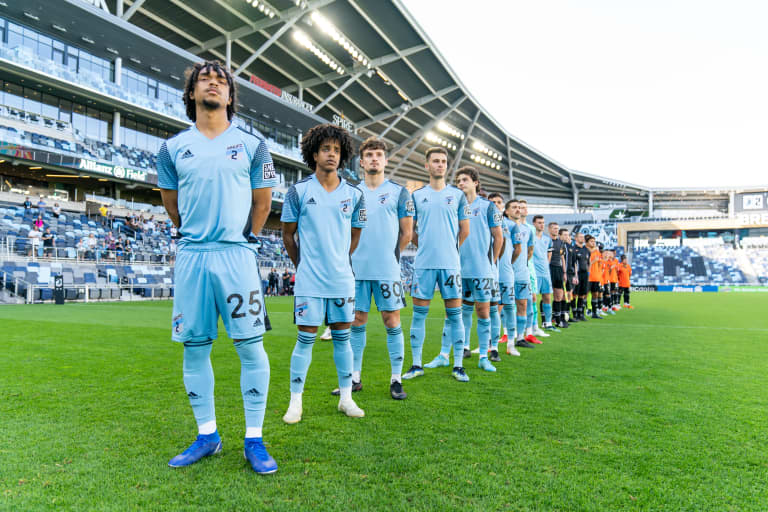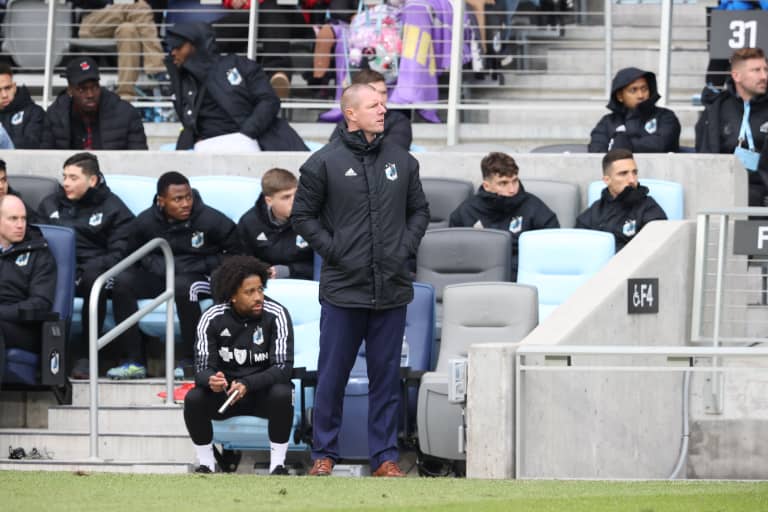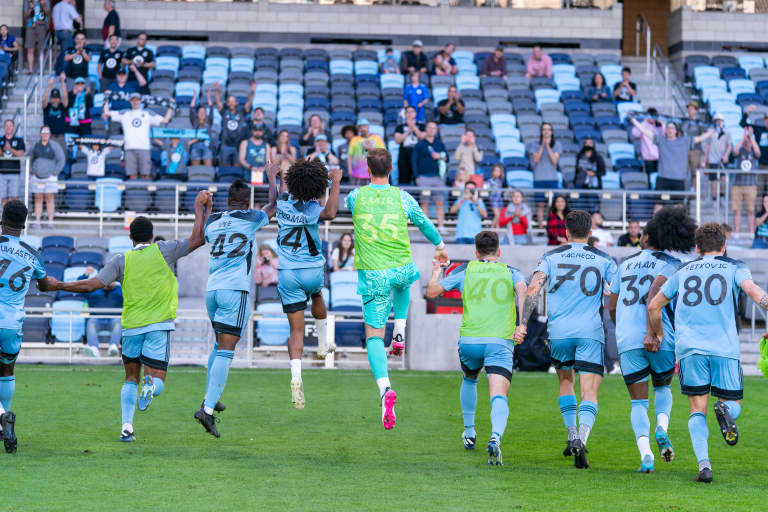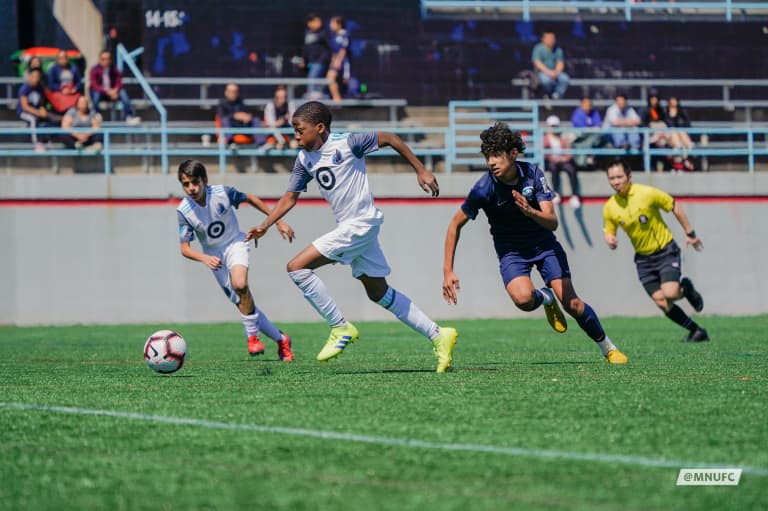As we round the halfway point of the inaugural MLS NEXT Pro season, it’s time to look back and see what the team has accomplished. MNUFC2 has come a long way in just 12 games, but their story extends far beyond the pitch. In this midseason report, we’ll take a look at how the Loons have adjusted to having a second team, some of the success stories that are already being written, and touch on some of the team’s notable performance metrics.

Completing the Pathway
In years past, various MLS teams have launched second teams in a variety of different ways. Whether they put their second team into the USL system or merely brokered a partnership with an existing lower-level team, creative solutions have been required due to the lack of a shared structure. Some examples include NY Red Bulls II, Atlanta United 2, and LA Galaxy II, all of whom currently play in the USL Championship.
Some MLS teams have had semi-organized second teams for years, while some teams have only just begun their second team programs. To help level the playing field and complete the path to becoming a professional, MLS decided to start MLS NEXT Pro.
When MLS introduced the idea of MLS NEXT Pro, it was meant to be an organized way to connect players from academies across the league to their respective first teams. This league gives players a legitimate chance to prove their worth at a higher level, with the ultimate goal being the production and preparation of future first-team players from MLS academy programs. In many ways, this league represents a bridge between the childhood dreams of academy players and the reality of being a professional soccer player.
In addition to completing the pathway, this league gives incredible flexibility to MLS teams as a whole. If a fringe first-team player needs minutes, MLS NEXT Pro provides them with that opportunity. If a star player is being eased back into the swing of things after an injury, they can get valuable minutes at this level before being rushed back into first team games. This is a place for learning and honing skills, no matter how much experience a player has.
This year marks the first year that Minnesota United has operated its MLS NEXT Pro team. MNUFC2 is coached by Cameron Knowles, who holds a USSF Pro License, was the former head coach of Portland Timbers 2 and is also an MLS Cup winning assistant coach with the Portland Timbers. In just half a year, the team has already begun to show that this stepping stone can be pivotal in the future of the entire organization.

Walking the Path
Loons fans are familiar with this pathway working properly already. Midfielder Aziel Jackson and goalkeeper Fred Emmings are just two perfect examples of the system working as it should be. While both are signed to first team contracts, they are competing with much older, more experienced players for first-team minutes. By joining the second team, these two, and several others, have been able to gain valuable experience and showcase their skills.
With the second team, Jackson has accumulated five goals and three assists after playing more than 800 minutes. Emmings has had the chance to start and go the distance in nine games with MNUFC2, developing skills and confidence in net. Both players were able to come into the club’s first-team friendly with SC Paderborn 07 and make a difference. Without game time, this may not have been possible for them.
Just as the pathway was meant to do, several MNUFC academy players have gotten a chance to step up on the second team. Midfielder Carlos Leatherman headlines a group of nine academy players who have made game-day rosters for MNUFC2, five of which have gotten the opportunity to get minutes.
Additionally, players signed to second team contracts have accounted for 44% of available game time. They have provided a backbone for this team, enabling Minnesota United to experiment with flexibility and the assuredness that they have a solid foundation to build upon. Players like Jason Ramos, Diogo Pacheco, and Tommy Williamson have been consistent pieces in an ever-changing lineup. Pacheco, in particular, has made a significant impact, contributing three goals and three assists this year. Midfielder Emmanuel Iwe has also proven to be a key player for the team, playing more than 800 minutes and contributing to three goals. Notably, Iwe was signed from the MNUFC2 open tryout, an important discovery that shows early success in the MLS Next Pro process in Minnesota.
On the other side of the coin, 15 first team players have featured in MNUFC2 games. In total, these players have played over 5,000 minutes, accounting for 42% of all available second team minutes. This includes younger players like Devin Padelford and Justin McMaster, as well as more experienced guys like Abu Danladi.
While the path has only just been paved, these players are already walking it. Moving forward, the club hopes to see more players follow in their footsteps to help this team’s impact on the organization grow.

The Journey, So Far
While the primary goal of the second team is to develop skills and get players valuable playing time at a high level, they are still focused on producing good performances. The best way to make improvements is by playing games, and no professional player wants to lose, no matter what stage they’re playing on.
When analyzing any MLS NEXT Pro game, it is important to keep in mind that the lineups could be almost anything from week to week. Every team has different priorities and will throw a unique mix of first and second team players onto the pitch. This means that results require a bit more insight than just a score line if you want to truly understand what happened on the field.
After 12 games, MNUFC2 has a record of 5-4-3. Though they lost their first two league games, the Loons went on an eight-game unbeaten run immediately after. This run included three draws, each of which they ended up winning on penalties.
The Loons started that unbeaten run with their first-ever MLS NEXT Pro win when they played Real Monarchs on April 3. This back-and-forth contest saw goals from defender Nabilai Kibunguchy, midfielder Aziel Jackson, and a 76th-minute winner from midfielder Diogo Pacheco. The game ended 3-2, though the Monarchs late second goal made the score line more flattering to them.
Some of the biggest score lines for the team include both of their games against Colorado Rapids 2, who they beat 4-0 and 5-1. Both games were at home, and both saw goals from Aziel Jackson, among other players. Additionally, MNUFC2 defeated St. Louis CITY2 4-0 in St. Louis.
While there have been some great wins, there have also been tough losses. The team has dropped two games to conference leaders North Texas SC, losing 3-1 and 4-0 respectively. When the team visited San Jose to take on Earthquakes II, they would see their unbeaten run end after a 2-1 defeat in heartbreaking fashion.
San Jose scored first late in the first half after earning and converting a penalty kick. After that, Minnesota applied the pressure, but failed to find the back of the net on multiple occasions. A Jason Ramos red card in the 69th minute saw the Loons go down to ten men, already down a goal. The team rallied, though, earning an equalizer via Diogo Pacheco in the 90th minute. While it looked like they would move to their fourth shootout of the year, a 92nd minute winner gave San Jose all three points.

Looking Forward
As the second half of the season arrives, new challenges and growing pains will almost certainly affect this young team. However, they have dealt with the stresses of their first season very well thus far, and there is no reason to expect that to change.
With MNUFC2 hovering right below the playoff line, they will be hoping to make a push for qualification. Nothing is out of reach for the Loons just yet, and with eight of their remaining 12 games at home, the team will be able to tackle the rest of the year from a more comfortable and rested starting point. It’s always better to play in the North Star State, right?
In the long term, success for this team is not measured by topping the league standings, although that is always a competitive goal they are shooting for. Instead, success for MNUFC2 means seeing the pathway working from top to bottom. Just like the players participating, the hope is that this program grows and develops into a fine-tuned training mechanism that helps players reach their highest potential during their time with Minnesota United FC.
Ideally, this means that from the bottom up, our players are hopeful and hungry. This league has created the path, now young Loons simply need to take advantage of it.

